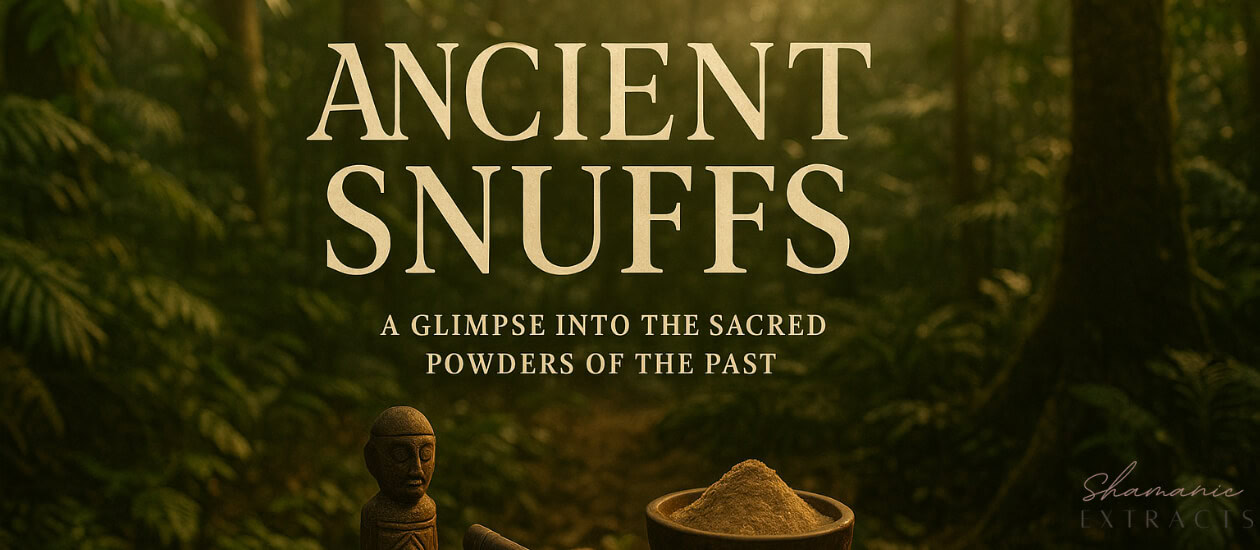Snuffs have a long and complex history. Long before modern tobacco products appeared, various cultures around the world used finely ground plant powders for rituals, healing, and spiritual connection. These ancient snuffs were not just for pleasure. They held deep meaning and were tied to the beliefs and traditions of the people who used them.
What Are Ancient Snuffs?
Ancient snuffs are powders made from plants. People would blow or inhale them through the nose. These powders often contained psychoactive ingredients, which could alter consciousness or create visions. Others had more gentle effects, like clearing the sinuses or calming the mind.
The word “snuff” usually makes people think of tobacco. But ancient snuffs included many different plants, depending on the region. Some were made from tree bark, seeds, herbs, or even roots. Often, they were blended with ashes or lime to activate certain compounds.
Snuff Traditions Around the World
Many cultures had their own snuff traditions. Here are a few of the most well-known:
1. Yopo (Anadenanthera peregrina)
Used by indigenous peoples in the Amazon and Orinoco basins, Yopo is a snuff made from the seeds of a tree. The seeds are roasted, ground, and mixed with ash. The result is a powerful psychedelic snuff that shamans use in ceremonies. It is often blown into the nostrils using a pipe or tube.
2. Vilca (Anadenanthera colubrina)
Similar to Yopo, Vilca comes from another type of Anadenanthera tree. It was used in ancient Andean cultures like the Tiwanaku and the Inca. Archaeologists have found evidence of Vilca use in ceremonial pipes and snuff trays dating back over a thousand years.
3. Rapé (pronounced ha-PAY)
Rapé is a general term for snuffs used by various tribes in the Amazon. These are usually tobacco-based and often mixed with other plants and ashes. They are used to focus the mind, open spiritual awareness, or cleanse negative energy. Rapé is still widely used today among indigenous people and in some alternative healing communities.
4. African Snuffs
In parts of Africa, especially among Bantu-speaking groups, snuff made from fermented tobacco leaves has been used for centuries. It is often part of ancestral rituals and social gatherings. While not always psychoactive in the same way as Amazonian snuffs, African snuffs also hold deep cultural importance.
How Were Ancient Snuffs Made?
The process of making snuff varied depending on the plants and the culture. But the steps usually included:
- Drying: Leaves, seeds, or bark were dried in the sun or over a fire.
- Roasting: Some ingredients were roasted to release active compounds.
- Grinding: The plant material was ground into a fine powder, often using stones.
- Mixing: Ashes, lime, or other ingredients were added to activate or balance the mix.
- Storage: The snuff was kept in gourds, tubes, or small jars until use.
Making snuff was often seen as a sacred act. Shamans or elders usually prepared it in special ceremonies, treating the plants with respect.
The Role of Snuff in Rituals and Healing
Ancient snuffs were more than just tools for altered states. They were central to many spiritual and healing practices.
- Connection to the spirit world: In Amazonian tribes, snuff helped shamans communicate with spirits or ancestors.
- Purging and cleansing: Some snuffs caused sneezing or mild nausea, seen as a way to purge bad energy or illness.
- Focus and clarity: Others were used before hunts or important decisions to clear the mind.
- Ceremonial offerings: In some cultures, snuff was blown toward sacred objects or offered to the gods.
These practices were rooted in a deep respect for nature. The plants were not seen as drugs, but as allies.
Snuff Tools and Techniques
The way snuff was taken also varied. Some used simple tools, while others created elaborate devices:
- Snuff tubes: Often made from bone, bamboo, or wood, these were used to blow snuff into the nostrils.
- Snuff trays and spatulas: In the Andes, carved trays and spatulas were used to handle Vilca powder.
- Double-ended pipes: Some tools allowed a person to self-administer snuff by blowing it into their own nose.
Many of these tools were decorated with symbols and animal figures, showing the link between snuff use and spirituality.
Are Ancient Snuffs Still Used Today?
Yes, in some areas they are still used. Indigenous communities in South America, Africa, and other regions continue to make and use traditional snuffs. They are part of their identity and way of life.
In recent years, there has been renewed interest in these practices from people outside those cultures. Some seek healing, while others are drawn to the spiritual aspects. But this has also raised concerns.
Some indigenous leaders worry that outsiders use these sacred tools without understanding their meaning. There is a risk of disrespect, cultural theft, or harm. It is important to approach ancient snuffs with humility and respect for the cultures that created them.
Conclusion: A Tradition Rooted in Respect
Ancient snuffs are more than powders. They are part of a larger system of knowledge, healing, and spirituality. Each culture that used them had its own way of preparing, using, and honoring these plants.
Today, we can still learn from these traditions. But we must do so carefully, with respect and responsibility. If used without understanding, these powerful tools can lose their meaning. When used wisely and with guidance, they can still offer insight and connection.
Whether you are curious about their history or exploring their modern use, ancient snuffs invite us to see the world through a different lens—one that honors the wisdom of those who came before us.

